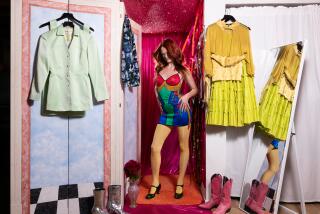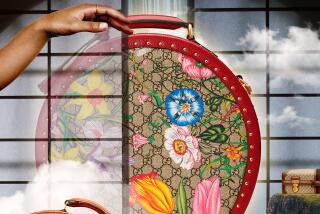TRAVELING in style : TRAVELING IN THE EXPRESS LANE : When the author’s book hit the best-seller list, he and his wife embarked on a European shopping spree that they still refer to as their ‘Spending Year’
- Share via
We called it our Spending Year , a shopping spree of Europe that came about when my novel, “Von Ryan’s Express,” hit the best-seller list. (Earlier we’d been living on money borrowed on my life insurance. Now, bankrolled by the book’s success, we took off on our dream trip.)
It was the first trek to Europe for my wife, Dody, and my fourth (transport for my first--during World War II--was provided by the U. S. Army Air Corps, and the amenities, such as they were, were provided by the Italian and German governments, I having been a prisoner of war).
Our journey began in France and wended its way to Switzerland, Italy and England. Along the way, our purchases included a luxury automobile, a fur coat, various watches, custom-tailored clothing and other incidentals for the two of us. Added to that were gifts for our sons plus remembrances for friends and other kin. As noted, this spending money came from my novel (my sixth but the first to hit the best-seller list).
For me, however, there would be more to the trip than scattering lire, pounds and francs. It was to be a sentimental journey tinged with bitter nostalgia. During World War II I had been a prisoner at PG 21, a camp near Chieti, Italy. When the Italians surrendered, I was transferred to German custody at Stalag Luft III, about 90 miles south of Berlin.
On this latter-day trip, there were places I wanted to revisit. The Crillon in Paris was our first stop. I’d been a guest at this remarkable hotel years earlier, just after having been liberated from a German prison camp. I told the clerk that the first time I’d stayed at the Crillon it had cost me 20 cents a night. That was in the spring of ’45 when the hotel was the Independence Club, a residence for officers on combat leave. By then, combat was finished; I was on leave from a processing center for liberated prisoners. I had a forged three-day pass, having already used my issued pass. After three days at the Crillon, I was so impressed with the billet that I forged another pass for an additional three days. (I’ve never felt a twinge of guilt about it, either.)
Before we left Paris, I stopped by the Hotel du Louvre where I’d also stayed during the war. I stood in the lobby remembering the confused young man I’d been back then, bewildered at being in Paris after long months in Italian and German prison camps. I’m not ashamed to admit that I cried.
Paris was good to us on this postwar trip, but as a spending spree it was a washout. Perhaps it was our timing. On our first full day in town, a Monday, most of the shops were closed, and it was cold and rainy. My wife, who is seldom to be denied, found a shop that remained open to catch the Monday trade and shipped assorted perfumes to a long list of friends and kinfolk. On a less restricted shopping day she bought driving gloves and shoes at Galleries Lafayette, for use with a car later purchased in London.
Our happiest Paris find is hanging in the room where my wife walks her treadmill and I type: four first-day-of-issue postcards celebrating the 100th anniversary of Henri de Toulouse-Lautrec’s birthday, each with a different full-color reproduction of a major Toulouse-Lautrec work.
So, you see, despite being nouveau riche, w e weren’t totally crass. We spent as many days visiting museums, galleries and historical sites as we did hunting for places to squander a buck.
Now in Zurich as a civilian, I spotted a watch in a shop window on the Bahnhofstrasse. The open-work band was of wrought gold scattered with tiny diamonds, and diamonds were on the watch face itself. It was exactly the watch for my wife. She protested but relented after the jeweler declared that it was one of a kind, designed by an Omega craftsman especially for an exhibition. It was also in Zurich that we bought her fur coat--black Russian broadtail with a red-and-black silk print lining.
Zurich is where I got my watch, too. I wanted one just like my navigators hack watch: stainless steel, sweep second hand, black face, luminous dial. Rolex made exactly what I had in mind, and I still have it.
From Zurich we took the train to Milan, another shopper’s paradise, with all the internationally-famous name brands and boutiques tucked in everywhere.
It was in Milan that we had our most expensive taxi ride, yard for yard. Outside the train station we asked a cabbie to take us to the Excelsior. He burst out laughing and tossed our bags into the trunk, installed us in the back seat and, still laughing--what a jolly fellow--made a U-turn and stopped in front of a stunning building.
“Hotel Excelsior,” he said.
After Milan came Florence, a city some say is pound for pound the spending-opportunity champ of the Old World with its objets d’art gold jewelry, gems, shoes, wearing apparel. And then it was on to Rome, where we shopped once more. My wife, having had her spree in Zurich, mostly stood back while I outfitted myself--a custom-tailored Brioni suit, a navy blue silk Brioni jacket, three pairs of Magli leather shoes. The jacket and one pair of the shoes are still serviceable, these years later.
Admiring the resplendently attired me in the pier glass, I remembered another less natty image of myself. After having been a POW in Italy, I was given a brand-new British wool battle-dress uniform to replace my summer-weight Italian model. Earlier, our Liberator crew had been shot down in flight coveralls, which our Italian captors had replaced with uniforms out of their own stocks. When we arrived at our permanent camp in the Abruzzi the commandant ordered the uniforms daubed with the letters “PG,” for prigioniero di guerra, and a circle-like target on the back of the tunic. My pilot called the uniforms clown suits and the senior British and American officers agreed. They complained to the management without success.
From that wonderful year (1965), I still have an outstandingly colorful tie that is banded with red, green and various shades of blue, and speckled with polka dots and diamond shapes. I found the tie in a smart boutique while on my own. I brought my wife back to see it and to advise me as to its suitability for a man of my years. She loved that tie--as well as a designer black-wool fitted coat with a satin-faced belt that she just had to have (at a cost of about 50 times the price of the tie).
Yes, it was our spending year.
From Rome I made my deepest inroad into nostalgia on a journey over the Abruzzi Mountains to the site of my Italian POW camp. I didn’t recognize it at first. The surrounding wall I’d thought so high, grim and forbidding seemed so ordinary. The blank-faced, heavy wooden double doors had been replaced by a gate, and beyond the gate were manicured lawns, lovely flowers and shrubs. During the period of my imprisonment there was only the bare earth, hard-packed by our restless boots.
At first, the young sentry on duty didn’t want to let me in (as a prisoner the guards hadn’t wanted to let me out). My interpreter persuaded the sentry to let her speak to the commandant, who welcomed me. The camp was now an Italian army school, with our cheerless barracks bays partitioned off into modern classrooms.
I gave the commandant a copy of my book, explaining that the camp was portrayed in the novel. At the same time I showed him a photo taken during the war of nine British officers and myself, dressed in British winter battle dress. The commandant rounded up eight of his officers and, posing all of us and himself exactly as the prisoners were posed in the old photo, had our picture taken. It hangs below the old one in my workroom, a photo exactly like the POW picture except that the commandant’s officers are in Italian uniforms and I stand with them in my silk Brioni suit.
On this combination shopping trip and sentimental journey, our final stop was London. No war memories here but spending opportunities galore. Here, we signed for delivery of a Vandan Plas Princess R automobile. All we knew about the car when we placed the order with a Los Angeles importer was what we’d seen and read in a magazine ad. Our first glimpse of the real article was not to come until we reached London.
We’ve never had another spending year, or any particular desire for one. I’m more mature now, and reflecting on the year my wife and I spent our money so recklessly, little realizing I’d never have another best-seller, I wondered recently if I’d do it over again. The answer: Of course. I’d do exactly the same. It was a happy time, a good time, an unforgettable moment that will never come again. Yes, it was worth every dollar, franc, lira and pound we spent. We bought memories. Lasting memories.
More to Read
Sign up for The Wild
We’ll help you find the best places to hike, bike and run, as well as the perfect silent spots for meditation and yoga.
You may occasionally receive promotional content from the Los Angeles Times.






